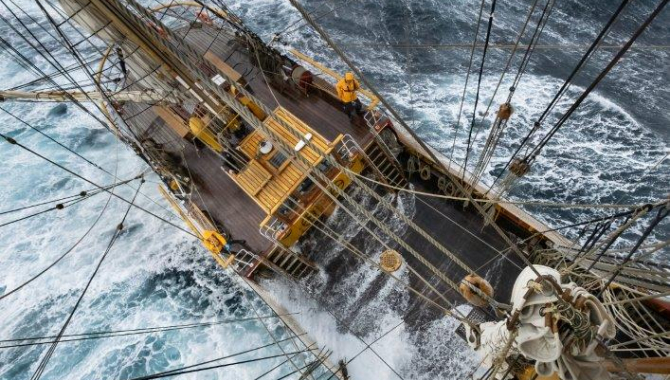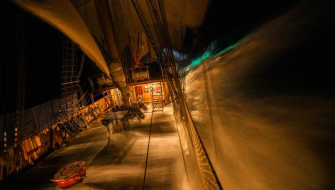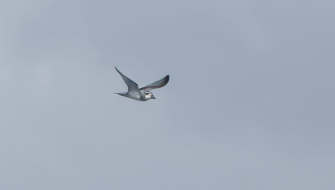Sailing a brave South Atlantic

Nature’s spectacle of a brave South Atlantic Ocean can be truly impressing, and indeed today it was.

It was last evening when they all started to increase and developed during the day.
Europa takes the weather and seas from the back, surfing the large waves with her rig reduced to just a handful of sails. On the Main just a single Topsail, on the Fore mast a Topsail and the Course. In the bowsprit, the Inner Jib and above the Main deck, the small Aap. In that fashion she takes the beating of the Roaring 40’s. Heavy rolling. Decks that often are washed by swells crashing on her sides of that manage to climb over her bulwarks.
Impressive, yes. Conditions that ask for taking care when hands are needed on deck, harnesses clipped on safety lines, boots filled up with water and wet foul weather gear together with the rest of clothes that we wear.
But she sails and runs those big seas still keeping a good speed. Yesterday over 200nm sailed, today 182.
Beautiful though imposing, often rolling wildly on those untamed waters we realise the grandeur of the ocean and its waves, we fathom that we are just a minor spec on a watery world of unleashed forces.
In the Roaring 40’s Westerly winds that travel around the world at those latitudes, generally blow hard. Their origin is in the combination of air being displaced from the Equator towards the South Pole, the Earth's rotation, and the scarcity of landmasses to serve as windbreaks.
Further south the Furious 50’s and Screeching 60’s have the same characteristics and even lower temperatures.
They all drive major current systems around the Antarctic Continent, and winds and currents moving the atmosphere and the seas create the different climate areas and distinct ecosystems in the world. Ocean and atmosphere are linked, they are both changeable, variable. In this latitudinal belt a Low Pressure follows another, slightly north from where we find ourselves, large Highs can dominate the system. Deep lows, compression areas between them and the Highs, situations that bring strong winds. Blowing over the sea surface for a long time they generate the gradually growing big swells that travel fast on the open ocean.
And today we sail these high seas, forceful winds, squalls loaded with rain and gusts reaching the 50kn and swells towering over our heads.

For many an impressive sight, for others the rolling seems to be a bit too much to walk around comfortably and prefer not to venture outside, let alone work on the washing machine that the main deck has become at times. But for sure the ones that seem to enjoy the most these conditions are the hundreds of Prions that join us on our adventurous sail. They fly in flocks around us, now shooting high above the brave seas, then disappearing behind a big swell.
They spend the journey flying around and having a closer look at us. And if there is a difficult group to identify amongst its several different species, it is them, even with experience some are usually unidentifiable at sea. They are from the petrel group, with their nostrils joined together in tubes atop their beaks, but they are well separated from the rest of those tubenoses with their unique pale grey plumage, a characteristic darker “W” shape over their wings and body, small size, peculiar bill structure and a fast, undulating flight pattern with great maneuverability.
At least two species were identified today, Antarctic and Broad billed, both from the genus Pachyptila, which comes from the Greek, meaning "thick" or "stout" “feather”.
The first ones are one of the common representatives of the Prion family in the region and further south too, breeding along several of the islands lost in the middle of the Southern Ocean.
The Broad billed prions nest close to the Subtropical Convergence including New Zealand region and Tristan Archipelago, where the main colonies are located, with an estimated total population of about 8 million pairs.
It is at night when wind and swells abate. We take the chance for changing tack, pulling braces now on the starboard side, sheeting staysails on Port tack and start setting more canvas once more. Now our course has straighten towards Tristan da Cunha from the general northerly heading during the last days.



